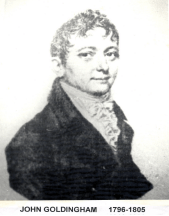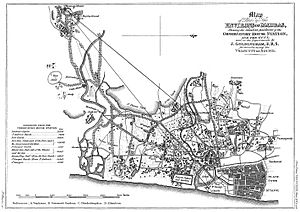John Goldingham facts for kids
John Goldingham (born in 1767) was a very important person in India's history. He was the first official astronomer at the Madras Observatory starting in 1802. An astronomer is a scientist who studies stars, planets, and space. Goldingham was also a talented architect and surveyor. A surveyor measures land and helps plan buildings. He even led a school in Madras that later became a big university called Anna University.
Contents
Early Life and Big Dreams
John Goldingham was born in London, England. This was in 1767. When he was young, he worked for another astronomer named William Petrie. Later, in 1788, he became an assistant to Michael Topping, who was an astronomer and sailor. Goldingham was originally from Denmark, and his first name was Johannes Guldenheim.
Building an Observatory
In 1792, John Goldingham was given a very important job: to build an observatory in Madras. An observatory is a special building with powerful telescopes used to watch the sky. He later became the main civil engineer for the area in 1800. Even though he was a mathematician, he taught himself a lot about astronomy and engineering. He worked around the same time as Colonel William Lambton, who started a big land survey.
Measuring Time and Land
One of Goldingham's key tasks was to figure out exact locations. From 1787, he observed the eclipses of Jupiter's moons. By timing these events, he could calculate how far east or west places were (their longitude). He figured out that the Madras observatory was at 18 degrees, 17 minutes, and 21 seconds East. These measurements were used for a while by the land survey team.
Madras Time: A New Standard
In 1802, Goldingham created something called Madras time. This time was 5 hours and 21 minutes ahead of GMT (Greenwich Mean Time), which is a standard time used around the world. This was a very early version of what later became Indian Standard Time in 1906. It helped people across India know what time it was.
Designing Important Buildings
Goldingham wasn't just good with stars and numbers; he was also a skilled architect. In 1800, he designed the Banqueting Hall. This grand building is now known as Rajaji Hall. He received a payment for his design work.
Sharing His Discoveries
After his work on the Banqueting Hall, Goldingham went back to being the Government Astronomer. He wrote two books about his observations. These books included his studies on how long a pendulum swings, how fast sound travels, and weather patterns. He also wrote about the exact locations (longitudes) of three important cities in India.
Later Life and Legacy
John Goldingham retired and moved back to England. He passed away in July 1849 in a city called Worcester. He was a member of several important scientific groups, including the Royal Society, the Royal Geographical Society, and the Royal Astronomical Society. His work helped set up important scientific studies and mapping in India.



